Dear reader: This article contains links to products and services that I may be compensated for, at no extra cost to you.
If you’re the kind of family that prefers ancient fortresses to amusement parks, waterfalls to shopping malls, and beaches to concrete jungles, then visiting Croatia with kids might just be the perfect holiday destination for you.
The 12,000-kilometer Dalmatian Coast, with its 1200 offshore islands, offers a lifetime of exploration opportunities for outdoorsy families. Medieval, UNESCO World Heritage old towns dot the coast, begging children to lead their obliging parents through (and of course get lost in) their networks of maze-like alleyways.
Take a few steps inland and you’ve got national parks filled with hundreds of waterfalls and vast networks of wooden trails traversing them. When it comes to dining, Mom and Dad are in for a treat, as the local wine is phenomenal, while the whole family will love the food. Last but not least, the leafy capital, Zagreb, is a very manageable size and offers a wide range of kid-friendly attractions.

In this article, I’ll cover how to visit each of the most popular destinations in Croatia with children, and I’ve enlisted the help of a handful of family travel experts to fill in the gaps of the places we never made it to.
The below entries begin in the south with Dubrovnik, Croatia’s most popular destination, and work their way north along some of the most iconic towns and best beaches in Croatia to the capital.
This is the same direction that we traveled when we visited, having just been to Kotor in Montenegro with our kids.

Table of Contents
Tips for Visiting Croatia with Kids

– Even for families (like us) who normally prefer public transportation, this is one country where you’ll want to rent a car. Driving in Croatia is a cinch, and bus journeys between towns can be long. We had a good experience with this rental service.
– We recommend staying in apartments that have kitchens. These were life savers for us. We’ve had many problems with Airbnb, however, so we recommend searching for apartments in Croatia here instead.
– Read these tips for traveling safely in Croatia and other information to know about Croatia before you go.
– Children under nine get major discounts for most attractions, and toddlers are usually free. In Zagreb, public transportation is free for five and under.
– You’re going to do a lot of walking in Croatia. Strollers are not ideal for exploring the cobblestone streets in old cities and paths in national parks, so consider investing in a good carrier like this one if your kids are too young to keep up.
– July and August are the peak summer season, but can be horribly crowded in popular places like Dubrovnik. Visit in May-June or September-October if you can.
Dubrovnik & Lokrum Island with Kids

Legendary Dubrovnik is the kind of place you feel you have to include on your itinerary, but you kind of dread actually visiting. At least that’s how we felt. Even in late October, the tail-end of the tourist season, the city was teeming with tourists, especially cruise ship passengers. Check any article about “overtourism”, and surely Dubrovnik will be mentioned. You can read my detailed guide to visiting Dubrovnik with kids to find our how we largely avoided the crowds and were pleasantly surprised by how much we enjoyed Dubrovnik.
The Old City of Dubrovnik is the quintessential medieval walled city. Your kids and you will feel as though you are staying in a real castle or a kind of outdoor museum. The city is so visually impressive that its no wonder it was chosen as King’s Landing in the enormously popular series Game of Thrones.
Today, Game of Thrones tours are all the rage in Dubrovnik, but our kids (aged 4 and 5 at the time of our visit) were too young to know about the show. Seeing all the dragon-related souvenirs in the shop windows was enough to intrigue them, but in the end, they were far more smitten by the old city’s small army of resident cats.
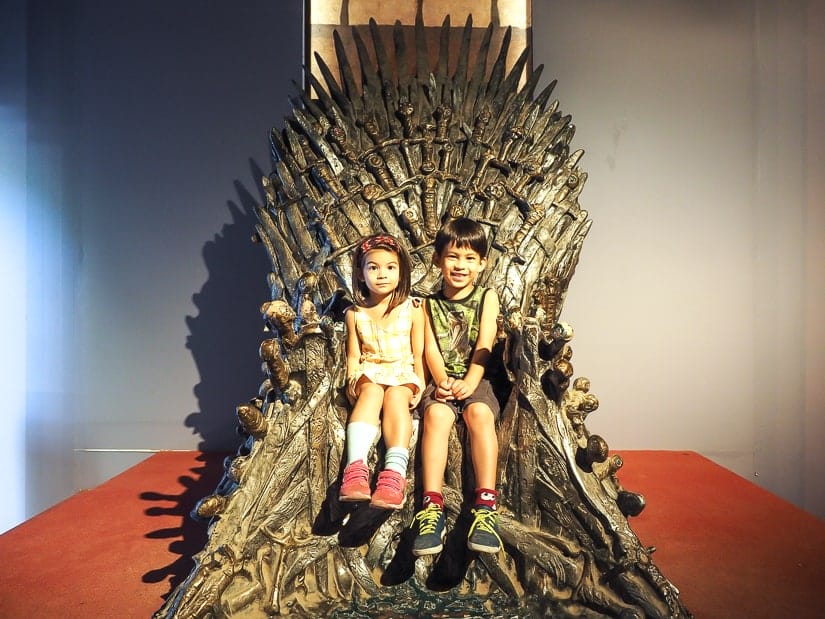
Setting aside all the historical palaces, churches, and so on that our kids didn’t particularly care to see, there and some great things to do in Dubrovnik with kids. Our family’s favorite was walking the entire circuit of the old city walls. Starting as soon as they opened, we were the only ones up there, and the views looking down on the red rooftops contrasting starkly with the navy blue sea in the background was breathtaking.

Riding the Dubrovnik Cable Car is another great option with kids, while Banje Beach is the perfect respite just out of town. But if there’s one things you don’t miss on your family trip to Dubrovnik, it’s taking a quick hop in the ferry to Lokrum Island, or as we called it, “Bunny Island.” Once home to a king, the island now features hundreds of rabbits, peacocks, a botanical garden, a mini “dead sea” for swimming, and the real Iron Throne from GoT!
We stayed in this apartment in Dubrovnik, and the location couldn’t have been better with kids!
You may also want to consider making a side trip from Dubrovnik to nearby Mostar in Bosnia and Herzegovina, or journeying south to Kotor and Perast in Montenegro, all of which we did and loved!
Also see my similar guides to visiting Italy with kids and Austria with kids.
Croatian Islands with Kids
by Chelsea from PackMoreIntoLife

The Croatian Islands are not to be missed when visiting Croatia. With over 1,000 islands to be discovered, it is hard to choose which island to visit.
Brač is one of the most popular islands and is easily reached by boat from the city of Split (see below entry). The island is known for its white pebble beach known as Zlatni Rat.
Hvar is another popular island easily reached from Split, known for its summer resorts and featuring a fortress, impressive 13th-century walls, and impressive Hvar Cathedral. Hvar is also a jumping-off point for venturing over to the Pakleni Islands, where families can discover hidden coves and private beaches.
Vis is yet another neighbor to Brač and is well known for its beautiful Blue Cave. Vis is a sleepier island since most visitors arrive at the cave by boat.

If you are looking for an island with plenty of greenery, head to Mljet Island, closer to Dubrovnik. Not only is the majority of the island covered by a national park but also it has beautiful lakes to swim in. As you can see, with so many islands it can be hard to choose which one is best for families!
Our personal favorite island was Brač. There we rented a paddleboat complete with slide to splash around in the beautiful warm waters, enjoyed the shade provided from the forest nearby to build castles in the sand, and relaxed at the nearby cafes.
Brac was easy to reach as a day trip from Split and is perfect for families thanks to its full services, playgrounds, and calm waters. To see all the Croatian islands we explore with our kids, see our Croatia 10-day itinerary, which includes 3-4 islands, starting in Dubrovnik and ending in Zagreb.
Search for family-friendly apartments in the Croatian Islands here.
Split with Kids
by Celine from FamilyCanTravel

Split is the second largest city in Croatia after Zagreb and lies on the shores of the Adriatic Sea in the thin stretch of southern Croatia. Whether you are looking to explore ancient history, eat fresh seafood, or experience modern Dalmatian life, you’ll find it here in Split.
In the beginning of our Croatia itinerary planning, we were advised to skip Split altogether. After a few days researching all the best things to do in Split with kids, we couldn’t disagree more. Running through narrow alleyways, exploring the bustling waterfront, climbing inside an ancient fort, plus beautiful beaches; what more could a kid ask for?
And it’s not just about the kids, while our young children had never heard of Game of Thrones, they happily joined in while we visited some of the famous shooting locations. Add in the fact that you can get almost everywhere you want to go by walking, plus easy access to delicious food right along the waterfront, we would argue that Split is incredibly family friendly and worth a visit.
We dedicated a day to exploring Split’s Old Town, including visits to Diocletian’s Palace, the Temple of Jupiter and the Vestibule. While we loved this, the two days that stood out for were when we visited Klis Fortress and walked through Marjan Park with a stop at the stunning Kasjuni Beach.

Klis Fortress is where the Meereen scenes from Games of Thrones were filmed, but it’s so much more than that. This fortress stands above the Klis village and is very near to Split. It’s location, up in the pass that separates two mountains, offers some of the most impressive views in the area. Our kids were thrilled to explore the lookouts and dark tunnels.
After a few days in a city we always look for opportunities to get into nature. We didn’t have to look very far in Split and we found some equally impressive views at the lookout points in Marjan Forest Park. Promising a beach at the end of a hike was enough to keep the kids moving, and who wouldn’t want to end their day at Kasjuni Beach? We love a city that has something for everyone!
Search for family-friendly apartments in Split here.
Trogir with Kids
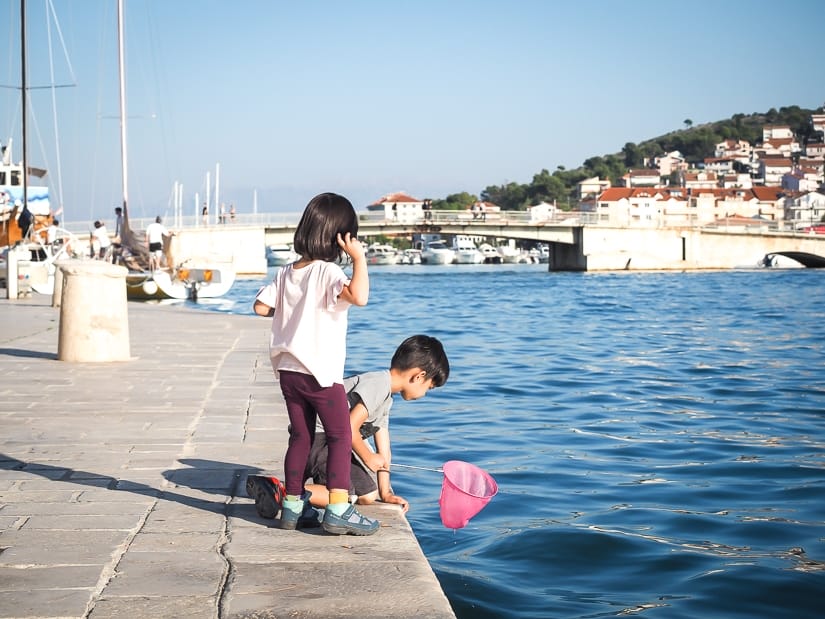
The tiny, UNESCO-designated old town of Trogir is one of the most charming and beautifully restored on the entire Croatian coast. Some even call it a “mini Dubrovnik”, but with far tamer crowds.
Trogir is only 30 minutes west of Split, making it an easy day trip from the latter. The old town of Trogir occupies a tiny island between the mainland and the larger island of Čiovo, with short bridges connecting the three. Besides the bridges and a ring road, the whole old town is traffic-free, including one of the most picturesque rivas (seaside promenades) in all of Croatia.

What you’ll most likely do is park your car in a lot on the mainland, then walk across a very short pedestrian bridge and into the tiny lanes to find your hotel. Not to worry, you can walk pretty much anywhere in the old town in just a few minutes, that’s how small it is!
While many people only visit for a few hours, we spent the night in Trogir. What’s more, we were visiting in late October, and while Dubrovnik had still be packed with tourists only a week earlier, we arrived in Trogir to find it was practically closed for the season. This meant we had the maze-like streets all to ourselves, perfect for exploring! Most of the restaurants were closed, but we were more than happy to self-cater in our lovely little apartment.

Besides a castle and cathedral, there really isn’t much else to do in town, but that is part of the appeal! There’s a pleasant leafy park around the north and east side of the island, a small playground below the castle.
If we can make only one recommendation, though, it’s that you must try the homemade ice cream at Gelato bar Bella. It’s to-die-for!
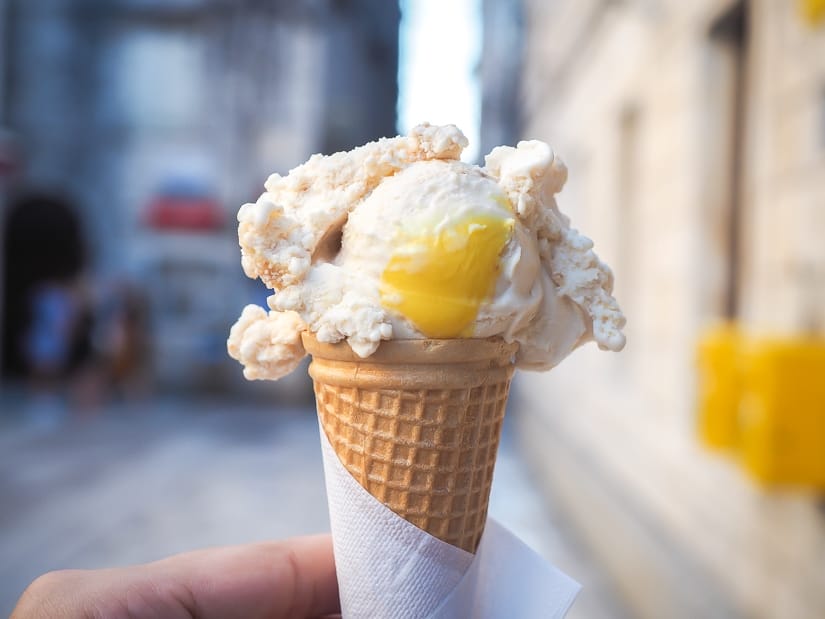
Šibenik Falconry Centre (Sokolarski Centar)

On the drive between Trogir and Skradin (for Krka National Park, see next entry), we stopped at the excellent birds-of-prey sanctuary for injured birds called Solarski Centar or Šibenik Falconry Centre. Our kids loved it (and so did we, actually!)
During the one-hour demonstration included in the price, we came face-to-face (literally, we got to rub our faces on it, because they don’t like hands touching them) with a majestic eagle owl. Sage also got to hold and feed a hawk.

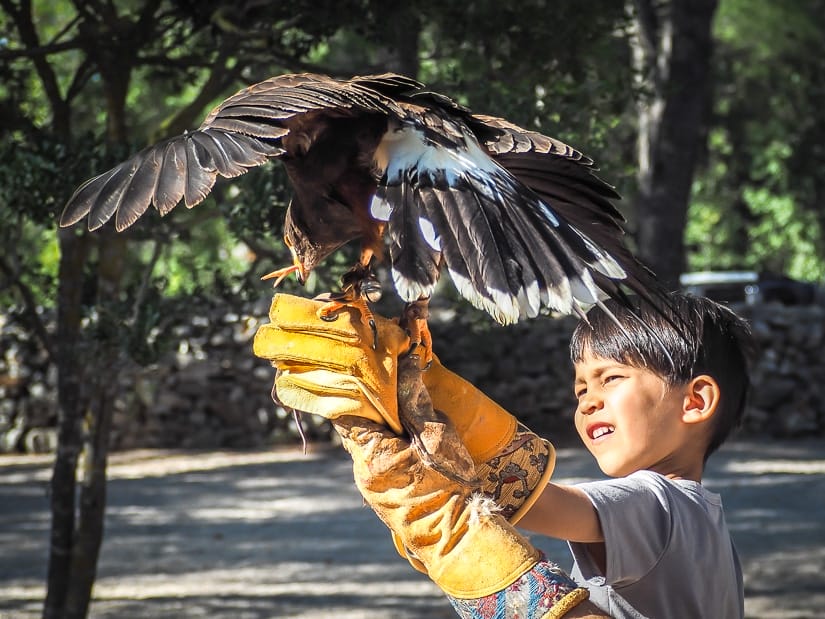
The animals are treated well and released into the wild upon recovery. The guide was extremely informative and funny. Overall, this was one of our favorite stops in Croatia!
You’ll need to drive to get there; it’s about 15 minutes from Šibenik or 25 from Skradin.
Skradin and Krka National Park with Kids
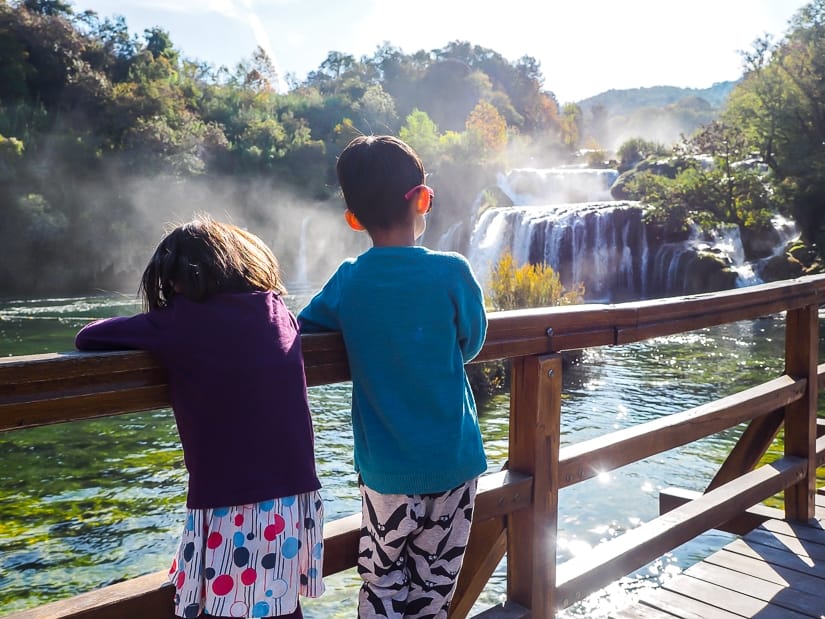
Croatia has two very popular waterfall-focused national parks. We managed to visit both, but if you can only do one, you may choose Krka because it is closer to the popular cities of Dubrovnik and Split.
Krka National Park encompasses a large and ecologically diverse portion of the Krka River, which flows from near the Croatian border with Bosnia and Herzegovina. The most famous section is Skradinski Buk, a large pool with multiple waterfalls where (unlike at Plitvice Lakes) swimming is allowed in summer.
Other possible stops you can visit by taking a longer ferry ride from there or by driving are Visovac Monastery on Visovac Island, Roški Slap, another beautiful waterfall furthest away from Skradin, and Krka Monastery.
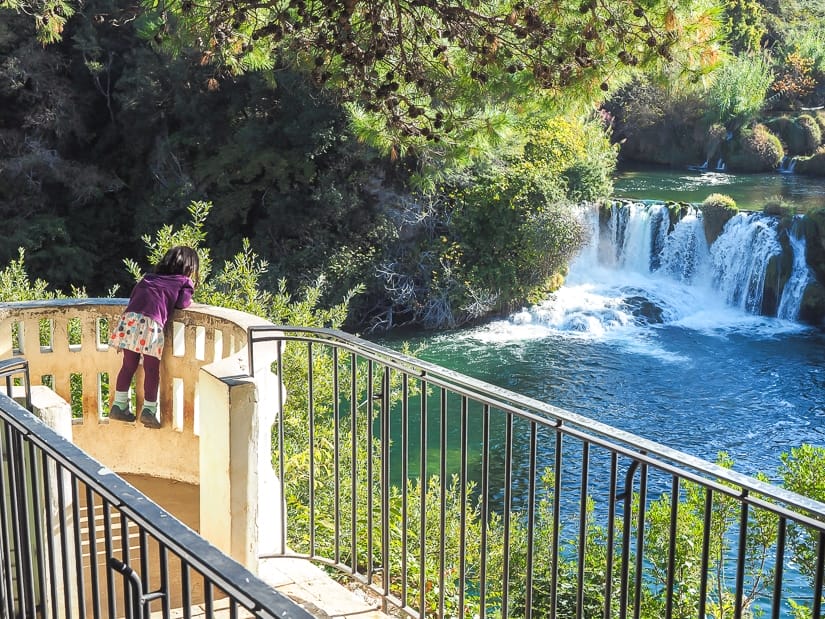

Most visitors enter the park by taking a 25-minute ferry ride from the small, idyllic town of Skradin. Krka can also easily be done as a day trip from Split or Šibenik (itself another gorgeous ancient coastal town, which hosts a children’s festival in early summer).
The ferry dropped us off near Skradinski buk, from where there’s an easy 1-1.5-hour walk taking in countless waterfall views. In several sections, the trail passes right over streams and small waterfalls, so you practically feel you are walking on the water. It was just the perfect length for our 4 and 5-year-old, getting us back to Skradin by lunch.

When we visited, we stayed at this simple guesthouse right in Skradin, allowing us to catch the earliest ferry into Krka. We loved Skradin, and staying there also allowed us to make a visit to Bibich Winery, one of Croatia’s most reputed, a 10-minute drive out of town. The winery was fun even for the kids, as the very kind and welcoming staff took them for a walk to see the resident donkeys while we sampled our wine!

Zadar with Kids
by Jurga from Full Suitcase

Zadar is probably the liveliest town we visited in Croatia and what made it really enjoyable was the fact that it felt more local and authentic than most other places, except maybe for Brac Island.
We didn’t know what to expect when visiting Zadar with kids or if it was even worth a visit. You always hear everyone mentioning Split and Dubrovnik and also the popular Croatian islands and National Parks… And while all those other places are incredible, they don’t have one thing that makes Zadar really special—the feeling of a place you would actually want to live in.
The nicest part of Zadar that you really have to visit is the walled city. As you enter the old town via one of its Venetian gates, you step back in time. From the Roman-era ruins to the medieval convent and impressive churches, this place breathes centuries-old history. However, everywhere you go, you also find nice little shops and lively cafés with outdoor terraces that invite you to sit down, get a drink or some ice cream, and just enjoy the moment.

Among our kids’ favorite things to do in Zadar was the beautiful 5 Wells Square—so much space to run around! Also, the Bell Tower of the Cathedral of St. Anastasia where we could climb all the way to the top of the tower. The views are amazing and there were pigeons nesting in the tower—the kids loved watching them. Just make sure you’re not anywhere near the bells at the hour, or you might find yourself with a ringing sound in your ears for the rest of the day.

Another place you really have to see is the seafront promenade (riva) and Zadar’s famous Sea Organ, a sort of a huge musical instrument that produces sounds when waves and wind hit the underground pipes. If your kids can never sit still, this is the place that will make them quiet for a couple of minutes—or else they wouldn’t hear the music of the sea!
One more observation for those who are thinking of visiting Zadar with young kids. It’s one of the very few cities in Croatia that is totally flat, so you can easily visit Zadar with a stroller.
Search for family-friendly apartments in Zadar here.
Rovinj with Kids
by Tea Gudek Snajdar from Culture Tourist

The beautiful coastal town of Rovinj is located in the westernmost part of Croatia, just across the Adriatic from Venice, Italy. It offers a lovely combination of Mediterranean vibes, old stone houses and shimmering blue Adriatic sea. It’s also ideally located in the central part of the Istrian peninsula, making it a convenient base for exploring other charming towns in the area.
Rovinj is one of my favourite child-friendly holiday destinations in Croatia. It has plenty of family-friendly accommodations, which often come with toys or little playgrounds to keep the kids entertained.
There are numerous things to do with kids in Rovinj. The old medieval city centre is a lovely place to explore with kids. Its stone streets are not great for strollers, though, so if travelling to Croatia with a baby, be sure to bring a child carrier. We loved taking a walk with my five-year-old son each evening there and exploring the many welcoming art galleries which Rovinj is famous for.
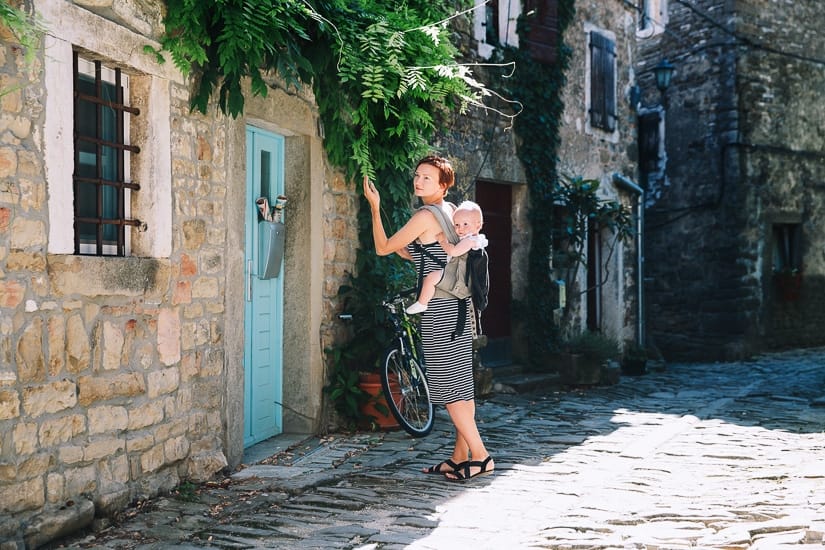
The town also has a rich fishing heritage, and it is a great source of local pride. A batana is a small fishermen boat typical of Rovinj. Twice per week a procession of batana boats takes place in the early evening. We observed it with our son and we all truly enjoyed it.
Following the procession, a typical fishermen dinner is organised, during which a band performs traditional music from the region. A few times per week fishermen dinners are organised at the seafront promenade, as well. The combination of fresh grilled fish, live music and street performers makes it a lovely thing to do with your kids in Rovinj.
Last but not least, Rovinj has multiple beaches to choose from. One of the best is Lone Beach, which is located just next to the forested coastal park Zlatni rt. The beach offers plenty of shadows, a lovely beach bar and a playground for kids.
Search for family-friendly apartments in Rovinj here.
Plitvice Lakes with Kids

For nature loving families, there’s one place you simply can’t miss in Croatia: the famed Plitvice Lakes National Park.
Compared to Krka National Park, Plitvice Lakes is larger, grander and, if you’re coming from the capital or places in the north, it will be easier to reach. Driving is still the best way to reach it, though, especially if you’re visiting with kids.
The national park encompasses 16 lakes in a region of karst sinkholes and subterranean rivers, with multiple streams and waterfalls connecting. Moss, algae, bacteria, and minerals form picturesque travertines and give the lakes their distinctive range of blue, green, and gray colors.

Plitivce Lakes was our final stop in Croatia before we went on to enjoy the autumn colors at Lake Bled in Slovenia. On the day we drove from Krka National Park, where autumn colors had already been on full display, the climate seemed to transform from dry Mediterranean to alpine, and the weather from warm autumn to full-on winter, in the span of a couple hours.
We actually froze our butts off at Plitvice. It was the first cold day of our trip after over a month of unusually warm weather, and our kids, who grew up in sub-tropical Taiwan, were struggled with it. On the plus side, the trails of Plitvice Lakes were completely devoid of people; if you visit in summer, we’ve heard the trails can be absolutely packed.

There are two main entrances and sections to the national park, the Lower Lakes and Upper Lakes. The Lower Lakes have the more famous views and the tallest waterfall, but the Upper Lakes are no less beautiful. There are also numerous recommended walking routes, labeled A, B, C, E, F, H, and K, ranging from 2-8 hours.
We stayed at this excellent apartment in Mukinje Village, which was a 20-minute (make that 30 with kids) walk from the Upper Lakes entrance and did route E, probably the easiest one. The route started with a short ferry ride across the lake and ended with a train-on-wheels ride back to the start. We never even made it to the Lower Lakes, but were very satisfied with how much we managed to see.
Throughout our trek, the lakes were covered in mist, giving them a hauntingly beautiful appearance. A highlight for the kids was spotting not one but two fire salamanders along the trail, something they would talk about for months to come.
Zagreb with Kids
by Melissa from The Family Voyage

Zagreb is Croatia’s largest city and its capital, but it’s one that many travelers overlook in favor of the country’s island and more iconic historic towns. But Zagreb presents a unique opportunity: you’ll see old and new side by side even if you just have a few days to explore. The newer “lower town” is home to hotels, restaurants, businesses, and expansive parks.
The feel of the medieval “upper town” is entirely different; the roads are narrow, winding and cobbled and the buildings are low-slung—including the very unique St. Mark’s Church, which your kids may think looks like it was built with Lego.
After exploring Croatia’s natural beauty and visiting smaller towns, Zagreb surprisingly felt more like Paris than Dubrovnik to us. We loved the vibrancy of the lower town and the lively restaurant scene. We visited in spring and there was tons of activity in the city’s “green horseshoe” over the weekend.

Our kids’ favorite activity was taking the funicular up the steep cliff separating lower and upper towns. Once we got to the top, we were greeted by the lovely green promenade filled with open-air bars, art displays and more. If your kids enjoy zoos, hop on the easy-to-use tram to visit Zoo Zagreb inside Maksimir Park, which is itself a wonderful oasis full of locals.
My biggest tip for visiting Zagreb is that you don’t need a car in the city – you can walk or take the tram anywhere you’d want to go. Many of the hotels and Airbnbs don’t have parking on-site so you can consider dropping your rental car off when you arrive in Zagreb if it’ll be your last stop, or delay picking it up until you leave the city if you’re just starting your journey. And if you’re planning a visit throughout the country, make sure to pack for a huge range of activities – you’ll want to get out and explore!
Zegreb would also be a good staging point to plan trip to Budapest with kids, which is only about 300 kilometers away!
Search for family-friendly apartments in Zagreb here.
I hope you found all the information you needed here for planning an amazing trip to Croatia with your kids. Let us know how your trip goes!




Thanks we’re off to Croatia with our kind
Ds this summer so this was super useful, we’re staying in Trogir
Thanks, and enjoy your trip!